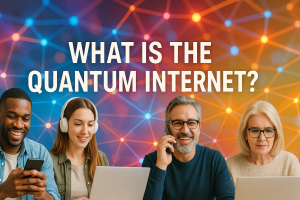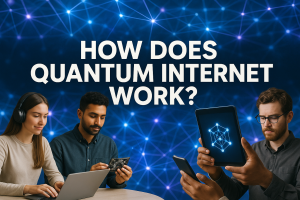Introduction Imagine an internet that cannot be hacked, where data transfers instantly and securely across continents. This is the promise of the quantum internet, a revolutionary leap beyond today’s networks. By 2025, researchers aim to link quantum devices in labs and cities, unlocking unheard-of speeds and ironclad data security. In this article, we explain what
Introduction
Imagine an internet that cannot be hacked, where data transfers instantly and securely across continents. This is the promise of the quantum internet, a revolutionary leap beyond today’s networks. By 2025, researchers aim to link quantum devices in labs and cities, unlocking unheard-of speeds and ironclad data security. In this article, we explain what the quantum technology internet is, how it works, and why it matters. You’ll see clear examples, simple tips, and real-world uses. Whether you’re a student or a business leader, you’ll gain a solid grasp of quantum connectivity, physical properties and how it will reshape our digital lives.
What Is the Quantum Internet?

Image by: Chatgpt.com
The quantum internet is not a faster version of today’s web. It is a new kind of network that uses quantum particles to send data. These particles can be in two states at once. This unique property allows for secure data transfer and instant links between devices.
Instead of sending bits (0s and 1s), quantum networks send qubits. Qubits can hold 0 and 1 at the same time. This feature opens doors to powerful encryption and error-free communication. Unlike 20th century classical channels, quantum links detect any eavesdropping right away.
How Does Quantum Internet Work?

Image by: Chatgpt.com
At the heart of the quantum internet are three key ideas: quantum entanglement, qubit transmission, and quantum repeaters.
Quantum entanglement, an entangled pair, binds two particles so that the state of one instantly affects the other, no matter the distance. If you measure one entangled photons qubit, you know the quantum state of its partner immediately.
To send information, a device encodes data onto entangled quantum bits, or qubits. These qubits travel through fiber optics or free-space links. Along the way, quantum repeaters boost the signal without breaking entanglement. This step overcomes distance limits that plague simple quantum links.
Thanks to these tools, data moves with minimal loss and maximal security. Any attempt to intercept the qubits changes their state. This shift alerts the sender and receiver to the breach.
Why Quantum Internet Matters in 2025

Image by: Chatgpt.com
Security is top of mind for governments and businesses. Today’s encryption algorithm methods rely on complex math that could one day be broken by quantum computers. The quantum internet solves this. It offers unbreakable data encryption based on physics, not math. This will protect everything from financial records to health data.
Beyond security, quantum networks can link quantum computers to form a distributed quantum cloud. Users could access massive quantum processing power remotely. This will accelerate breakthroughs in chemistry, materials science, and artificial intelligence.
Furthermore, quantum links can enhance clock synchronization. Networks that sync clocks to extreme precision benefit navigation, finance, and scientific experiments. Next-gen networking will thus power not just data transfer but also precise timing for critical quantum systems.
Benefits of Quantum Connectivity

Image by: Chatgpt.com
The quantum internet offers three major advantages over classic networks:
- Unbreakable Security: With quantum encryption, any hack attempt is instantly visible. Data cannot be copied without detection. This level of security protects sensitive data information like financial transactions and health records.
- Ultra-Fast Data Transfer: Qubits can carry more information per particle than classical bits. This boost means faster links for science experiments, cloud classical computing, and large file transfers.
- New Computing Possibilities: By linking quantum computer science across a network, researchers can solve complex problems together. Fields like drug discovery and climate modeling will reach new heights.
These benefits make quantum networking a game-changer for governments, businesses, and research labs.
Key Technologies Driving Quantum Connectivity

Image by: Chatgpt.com
Several technologies converge to build the quantum internet:
- Quantum Repeaters: These devices extend the range of entanglement by swapping and purifying qubits along a chain of nodes.
- Superconducting Qubits and Photonic Qubits: Superconducting circuits are used in labs. Photonic qubits, carried by light particles, travel well in fiber and free space.
- Quantum Memories: These store qubit states long enough for network operations. They act like buffers in classical networks.
- Entanglement Swapping: This technique connects distant nodes by entangling intermediate pairs and then swapping entanglement.
- Quantum Routers and Switches: These will direct qubit traffic much like routers send data packets today.
Together, these technologies form the backbone of entanglement networks in 2025.
Real-World Applications

Image by: Chatgpt.com
By 2025, we expect pilot projects and early services that harness the quantum internet:
- Secure Government Communications: Embassies and defense agencies will test quantum links for top-secret chats to secure communications.
- Banking and Finance: Banks will exchange encrypted data over quantum channels, reducing fraud and risk.
- Healthcare Networks: Hospitals will share patient data with zero risk of tampering, improving telemedicine.
- Science Collaborations: Research centers across continents will run joint quantum simulations, speeding breakthroughs.
These examples show how quantum communication will touch daily operations long before full global networks emerge.
Tips for Preparing for Quantum Internet

Image by: Chatgpt.com
You don’t need a classical physics degree to get ready. Here are simple steps:
- Learn the Basics: Read free online courses on quantum mechanics and networking.
- Follow Trusted News: Subscribe to tech newsletters that cover quantum research.
- Explore Simulators: Try quantum coding kits like IBM Quantum Experience to see qubit behavior.
- Plan Upgrades: If you manage IT, talk to vendors about future-proofing your infrastructure.
- Build Partnerships: Connect with universities and startups working on quantum projects.
These actions help you spot opportunities and avoid surprises when ultra-secure internet services launch.
Challenges and Limitations
Despite progress, quantum internet faces hurdles. Building and maintaining quantum hardware, such as single-photon detectors and cryogenic transmitters, is costly and complex. Quantum signals weaken over distance, so repeaters or satellites must be precisely aligned and kept cold. Standardizing equipment and protocols across different countries and companies remains a work in progress. Finally, training enough experts who know both quantum physics and network engineering is a major bottleneck.
Despite its promise, the quantum internet faces hurdles:
- Fragile Qubits: Qubits lose their state easily due to temperature changes or vibrations. Labs must keep them near absolute zero.
- Infrastructure Needs: Fiber networks need upgrades to handle quantum signals. Cities and campuses must lay new cables or use satellite links.
- Cost and Scale: Early quantum networks cost millions to build. Scaling from small testbeds to global links will take time and funding.
Researchers are tackling these issues with better materials, improved repeaters, and more robust qubit designs. As costs fall, adoption will grow.
Future of Quantum Internet in 2025

Image by: Chatgpt.com
Looking ahead, quantum internet will grow from small testbeds into larger regional networks. Engineers are working on practical applications quantum repeaters to extend link distances without losing qubit integrity. Hybrid physical systems will let everyday users tap into quantum-enhanced security alongside normal internet service. As more nations join, global quantum links may connect major cities and research hubs. Over time, this network could enable new kinds of distributed computing, ultra-secure commerce, and even quantum-powered scientific discoveries. The future of connectivity is set to expand in ways we are only beginning to imagine.
Comparative Table: Quantum Internet Features
| Feature | What It Means | Benefit |
|---|---|---|
| Quantum Entanglement | Paired qubits share instant state information. | Instant, tamper-proof communication. |
| Qubit Transmission | Data travels via qubits in fibers or satellites. | Higher data density, faster transfers. |
| Quantum Repeaters | Boost signals without collapsing qubit states. | Extends range to cover cities and nations. |
| Quantum Encryption | Keys generated by qubit states. | Alerts on any interception attempt. |
| Distributed Quantum Computing | Links quantum computers over a network. | Solves large problems jointly. |
Conclusion
Quantum internet stands to change our digital lives with unmatched speed and security. As you have seen, its quantum connectivity allows data transfer with near-zero risk of interception. Businesses, schools, and governments will gain new tools for research and communication. The move will be gradual, but the impact will be broad. Start learning about quantum networks today. Build skills in quantum communication and encryption. Stay curious and follow trusted sources. The future of ultra-secure internet is near. Embrace quantum key distribution qkd internet to stay ahead in a connected world. Be ready today.
















